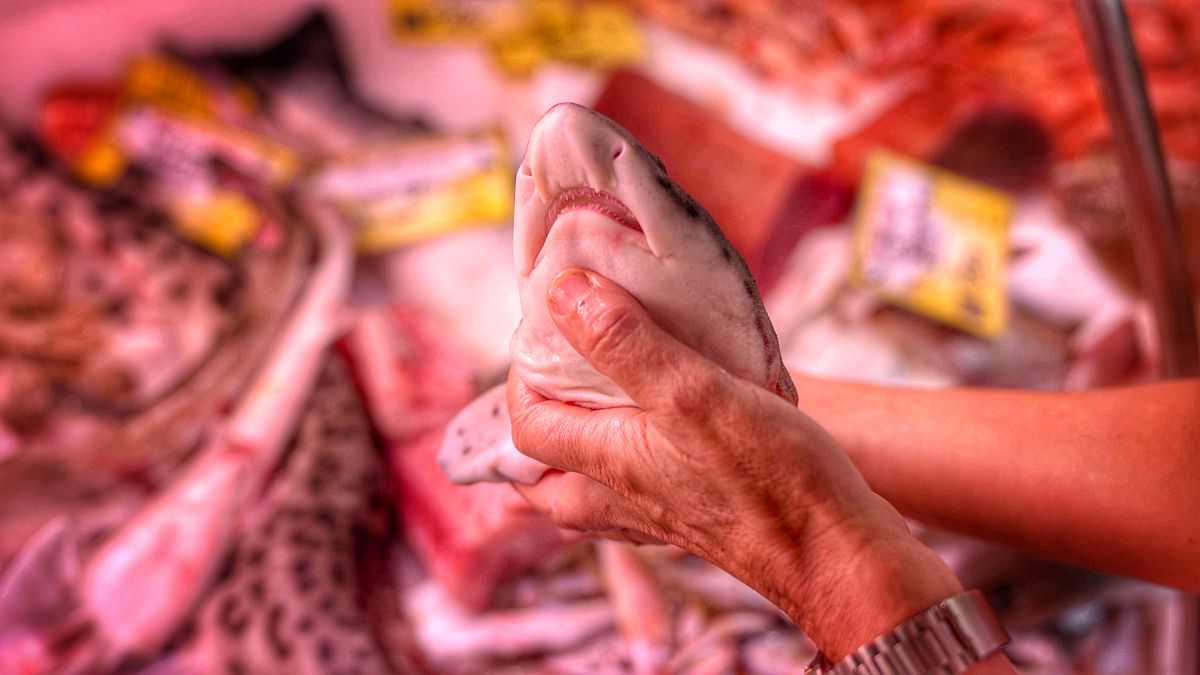Could changing our perception of sharks help save Europe’s oceans?

Sharks in Europe’s seas are silently struggling to survive. We meet the researchers and volunteers working to change perspectives and protect marine life.
At the foot of Vesuvius on the western coast of Italy lies the Bay of Naples, renowned for the beauty of its surrounding area and the richness of its marine life.
A few years ago, Italian journalist and marine researcher Eleonora de Sabata, following a tip from local divers, discovered a true living treasure in one of the bay’s underwater reefs.
Shark eggs, also known as mermaid’s purses, are cradles of life for some of the dozens of shark species living in the Mediterranean. But sharks are silently struggling for survival in their own habitat.
In the crevices of Europe’s underwater reefs live nursehound sharks; a species harmless to humans and crucial for the marine ecosystem. Each can be identified by a unique pattern of specks.
Eleonora assigns each shark a personal name. But her observations reveal that instead of increasing, the local shark population is collapsing.
“When we started this survey, you could find hundreds of egg cases in this area. Now, ten years later, there are only dozens,” Eleonora de Sabata told Ocean.
“Sadly, this is something that is happening everywhere in the Mediterranean Sea. It’s not that there are people who are actively catching sharks, but they get entangled in nets and hooks that are meant for other species. And then we change their environment a lot. They need quiet, they need places where the baby sharks can rest and shelter and can find food — and we’ve transformed every coastal area. So they’re not doing too well.”
The need for cultural and culinary shifts in perceptions
Since the 1970s, the shark population in the northern Tyrrhenian Sea has plummeted by 99%. Yet, this crisis often remains unnoticed.
The Livorno Aquarium participates in the EU-funded project LIFE European Sharks, which aims to educate Europeans of all ages about sharks and their close relatives, rays. Many believe that sharks’ sinister image might be hindering efforts towards their conservation.
“These animals need to transition from the negative perception created by cinema to a more sustainable, environmentally focused image, one that reflects the crucial ecological role they play in the environment,” explained Giovanni Raimondi, a Scientific Coordinator at the Acquario di Livorno.
The cultural shift must also extend to culinary choices. Sharks in European waters are often caught by accident and are considered low-value fish. However, bycatches can be sold in areas such as Livorno, where consuming shark meat is a tradition.
Eleonora de Sabata, who leads the LIFE European Sharks project, works with fishermen to ensure that protection measures are respected and that at least smaller sharks are released alive.
Many restaurateurs are sympathetic. Sustainably caught local fish can perfectly well substitute shark meat, even in traditional dishes like the famous Livorno fish stew, cacciucco.
“We aim to use different types of fish, intentionally avoiding shark, to support the species’ reproduction,” revealed Deborah Corsi, one of many chefs involved in this European project.
Shark-free cacciucco remains just as delicious — a small but meaningful step towards preserving European shark populations. There is still a long journey ahead to achieve this goal.
“It’s complicated to reverse the decline of sharks in the Mediterranean Sea because the only solution will be to stop fishing — and that is impossible for a number of reasons,” said Eleonora de Sabata.
“So our approach is to try and focus on the human element and change the perspective on sharks from being dangerous to endangered. Each and every one of us can actually do something tangible to help sharks recover.”
It’s a challenging task, but there’s good reason to hope that by working together, things can be made better.
How citizen science is helping to save angelsharks
Fuerteventura, one of the Canary Islands, isn’t just a hotspot for beachgoers and SCUBA divers; it’s also one of the last strongholds for an amazing species that used to be common along European shores: the angelsharks.
They look a lot like rays and live in shallow waters, which has made them all too common as accidental catches in bottom trawling.
“Now they are classified as a critically endangered species, so it’s as bad as it can get for a species before it disappears,” explained Eva Meyers, the Co-Founder and Co-Lead at the Angel Shark Project.
“But the good news is that now that we are paying more attention to them again, they are starting to appear again in a lot of places, which is very exciting. We established a citizen science reporting map, so that all the divers that were going into the water, if they would see an angel shark, they could report it to us.”
Eva Meyers leads the Angel Shark Project, a joint effort by European research groups to study and safeguard these species. A big part of their work relies on ‘citizen science’ that reports every encounter with angel sharks.
“We can say if we saw an angel shark at this dive site, in these depths. He was acting like this. It was a male, a female, the water temperature… it’s like a swarm intelligence, and we can help,” said Volker Berg, the Owner of Deep Blue Diving.
“They’re telling us more about the habitat, they’re telling us about the threats,” Eva Meyers told Ocean. “They’re the ones actually taking care of the sharks in their areas. They’re the guardians of the angels.”
We joined the Angel Shark Project team to explore one of the local habitats of this species. Studying such sites might reveal ways to revive their populations in the Northeast Atlantic and the Mediterranean Sea.
Working with the team is Felipe Ravina Olivares, who transitioned from a Canarian marine scientist to a pro underwater videographer. His documentaries are a rallying cry for protecting the environment and the unique marine life of the archipelago, including the angelsharks.
“Here in the Canary Islands, since we don’t have bottom trawling, angelsharks have managed to survive and we have a stable population. We see them throughout the year, from hatchlings to adults, and it’s truly amazing. I take great pride in this, and my mission is to spread awareness about the importance of the angelshark. We need to protect them because they’re a unique treasure in the world.”
The team tags any sharks they find to better understand their habitats and migration paths. Thanks to the data gathered by both professional and citizen scientists, authorities are increasingly able to protect these sharks from accidental fishing and other threats.
“I have a lot of hope. There have been new protected areas established in different places that are definitely going to help. So I am confident that we’re going in the right directions with a few very, very hard challenges ahead of us, though,” Eva Meyers concluded.
Life in our seas relies on a full range of biodiversity, from plankton up to apex predators. Sharks must be saved to keep the ocean healthy.
Source: Euro News














